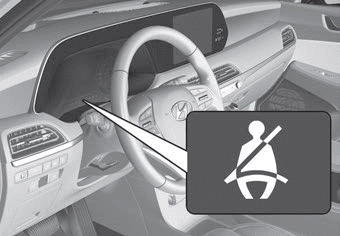Hyundai Palisade: Charging System / Description and operation
Hyundai Palisade (LX2) 2020-2025 Service Manual / Engine Electrical System / Charging System / Description and operation
| Description |
The charging system includes a battery, an alternator with a built-in regulator,
and the charging indicator light and wire.
The Alternator has eight built-in diodes, each rectifying AC current to DC current.
Therefore, DC current appears at alternator "B" terminal.
In addition, the charging voltage of this alternator is regulated by the battery
voltage detection system.
The main components of the alternator are the rotor, stator, rectifier, capacitor
brushes, bearings and V-ribbed belt pulley. The brush holder contains a built-in
electronic voltage regulator.
| Alternator Management System |
Alternator management system controls the charging voltage set point in order
to improve fuel economy, manage alternator load under various operating conditions,
keep the battery charged, and protect the battery from over-charging. ECM controls
generating voltage by duty cycle (charging control, discharging control, normal
control) based on the battery conditions and vehicle operating conditions.
The system conducts discharging control when accelerating a vehicle. Vehicle
reduces an alternator load and consumes an electric power form a battery.
The system conducts charging control when decelerating a vehicle. Vehicle increases
an alternator load and charges a battery.
Other information:
Hyundai Palisade (LX2) 2020-2025 Owner's Manual: LCD display message
Shifting conditions not met The warning message appears on the LCD display, when engine RPM is too high, or when driving speed is too fast to shift the gear. We recommend you decrease the engine speed or slow down before shifting the gear. Press brake pedal to change gear The warning message appears on the LCD display, when the brake pedal is not depressed while shifting the gear...
Hyundai Palisade (LX2) 2020-2025 Owner's Manual: If the Engine Will Not Start
If the Engine Doesn't Turn Over or Turns Over Slowly Be sure the shift button is in N (Neutral) or P (Park). The engine starts only when the shift button is in N (Neutral) or P (Park). Check the battery connections to be sure they are clean and tight...
Categories
- Manuals Home
- 1st Generation Palisade Owners Manual
- 1st Generation Palisade Service Manual
- Changing Tires
- Electrochromatic Mirror (ECM) with homelink system
- Check Tire Pressure
- New on site
- Most important about car
Seat Belt Warning Light
Seat belt warning light

Driver's seat belt warning
As a reminder to the driver, the seat belt warning light will illuminate for approximately 6 seconds each time you place the ignition switch to the ON position regardless of belt fastening. At this time, if the seat belt is not fastened a warning chime will sound for 6 seconds.
Copyright © 2025 www.hpalisadelx.com


